#19th c dress
Explore tagged Tumblr posts
Text
@doomhamster, no, damask is a way of getting a complex pattern like flowers or stripes with the texture of the weave, instead of a print. it's common in (older?) linen tablecloths and napkins, and still used in some home dec fabrics. it's often used as a way of getting a figured pattern in a single-color fabric (but can also be multi colored).
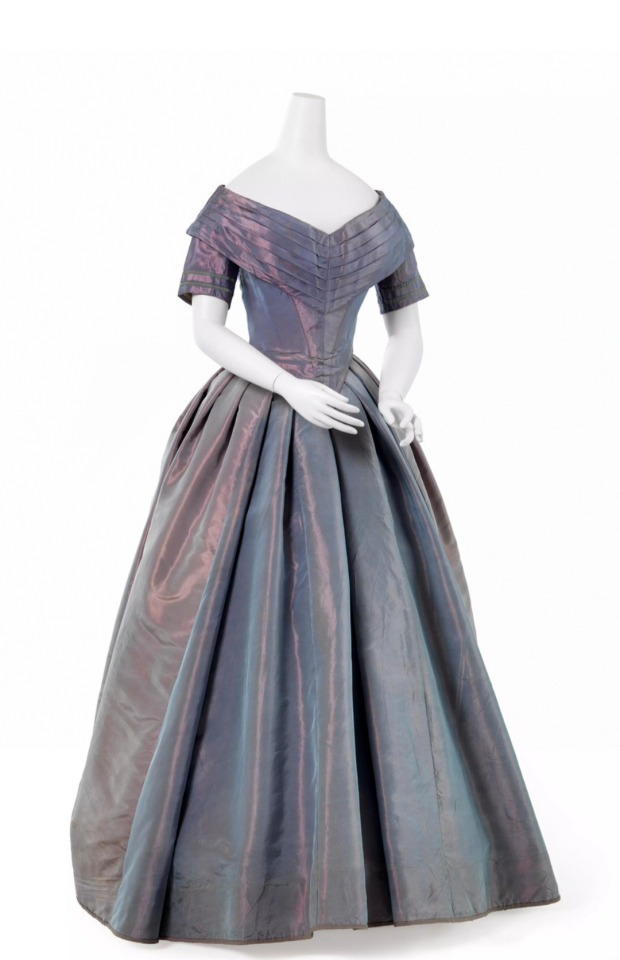
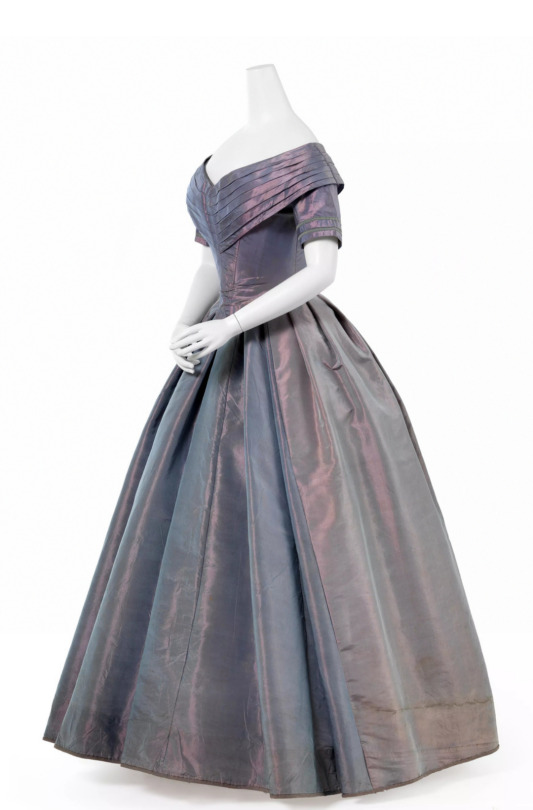
Ball gown, 1840-41
Maker: Unknown
From the collection of Wien Museum
18K notes
·
View notes
Text

Prithvi Bir Bikram, King of Nepal with his wife Queen Divyeshwari, c. 1886-1900s
260 notes
·
View notes
Text

L'Art et la mode, no. 42, vol. 15, 20 octobre 1894, Paris. Créations inédites. Dessin de C. Billié. Bibliothèque nationale de France
Toilette de ville en drap mastic, brodé au plumetis sur un dessous de velours hanneton. Corsage de velours garni de bretelles formant choux à la taille. Manches larges, poignets drap brodé. Chapeau 1830, en feutre mastic, garni de velours hanneton.
City ensemble in mastic cloth, embroidered with plumetis on a chafer velvet underside. Velvet bodice trimmed with straps forming cabbages at the waist. Wide sleeves, embroidered cloth cuffs. 1830 hat, in mastic felt, trimmed with chafer velvet.
—
Robe de visites, en velours Parme, brodée de jais, garnie de vison et de velours aubergine. Manches toutes brodées. Chapeau en feutre noir, garni de plumes et de roses de velours aubergine.
Visiting dress, in Parma velvet, embroidered with jet, trimmed with mink and aubergine velvet. Fully embroidered sleeves. Black felt hat, trimmed with feathers and aubergine velvet roses.
—
Collet en fourrure, garni de velours gris mauve rebrodé formant longues pointes devant. Choux aux épaules. Capeline Louis XVI, garnie de plumes noires et de violettes.
Fur collar, trimmed with mauve-gray velvet embroidered into long points at the front. Shoulder puffs. Louis XVI wide-brimmed hat, trimmed with black and violet feathers.
—
Collet en velours noir et moire blanche brodée de jais. Bord de plumes noires, bretelles en velours noir. Chapeau "petit abbé", garni de plumes.
Collar in black velvet and white moire embroidered with jet. Edge of black feathers, straps in black velvet. "Petit abbé" hat, trimmed with feathers.
—
Manteau de voiture, en velours noir et hermine, rattaché aux épaules par des motifs de jais et cabochons; revers en soie vieux rose, avec jais en bas. Toque en plumes noires et velours vieux rose. — Manchon velours.
Car coat, in black velvet and ermine, attached at the shoulders with jet and cabochon motifs; old pink silk lapels, with jet at the bottom. Black feather and old pink velvet toque. — Velvet muff.
#L'Art et la mode#19th century#1890s#1894#on this day#October 20#periodical#fashion#fashion plate#description#bibliothèque nationale de france#dress#coat#cape#gigot#Modèles de chez#C. Billiè#collar
89 notes
·
View notes
Text
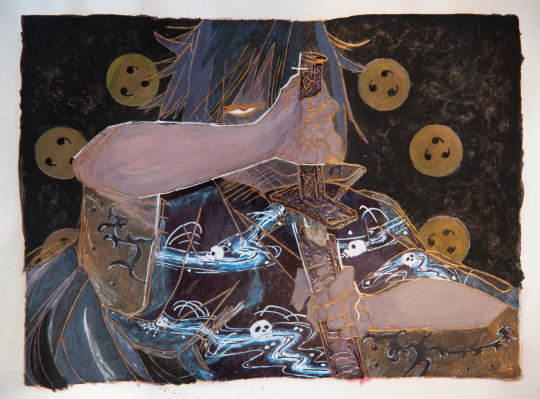
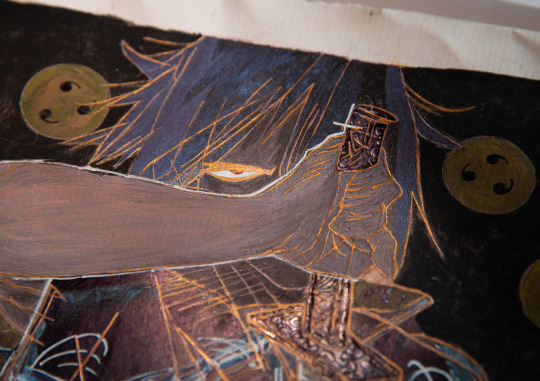
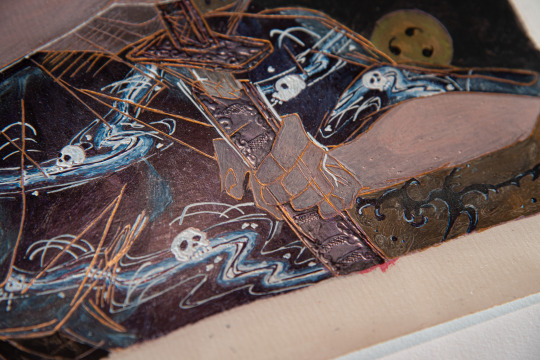
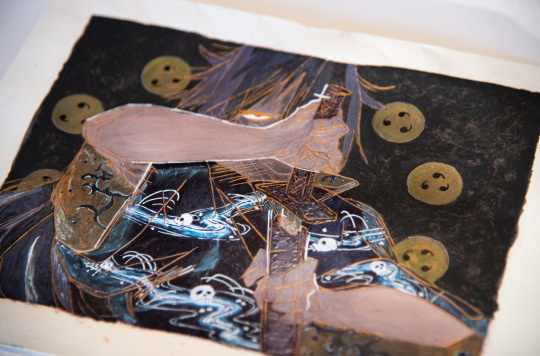
Another year, another outfit to die in! Happy birthday again Izuna!!!!!!
Like last year, I played with someone else's lines for these charming patterns, thank you so much Lena @elhnrt ! I had a ton of fun :D
Check the readmore for pattern references and explanations, there are some easter eggs in there :)
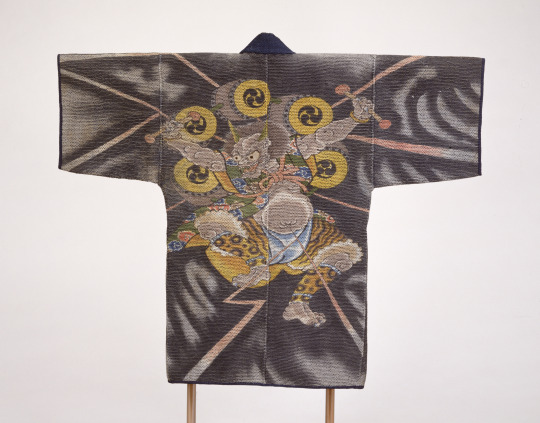
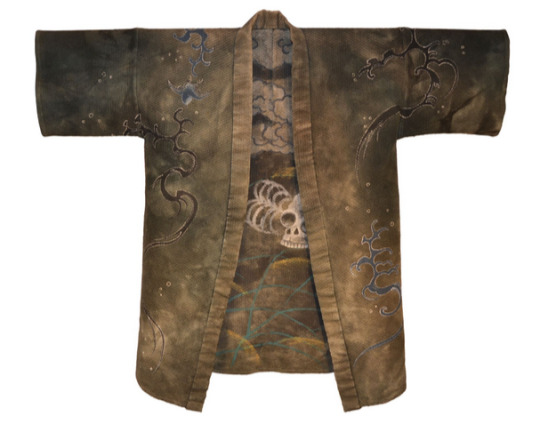
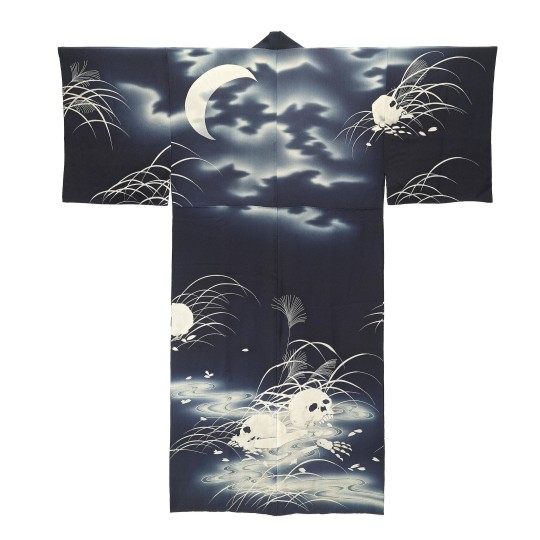
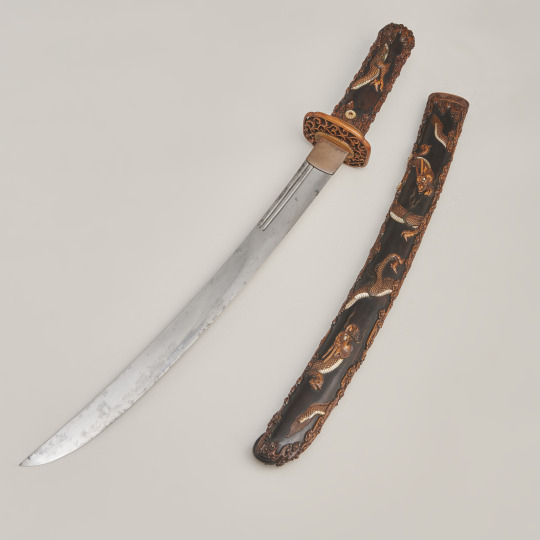
(x,x,x,x)
My goal for this piece, in addition to playing with patterns and textures and adding some Naruto references, was to add as many death flags as possible.
The idea of having Izuna in a fireman's coat is obviously not from me. I've always like the idea of Uchihas in fire resistant clothes, and the opportunity for a thick texture alongside a reversible double pattern is very appealing. I used the image of the second reference as a base, with skulls on one side and stylized lightning patterns on the other (visible inside the sleeves and collar). Both were common immagery of firemen coats.
The actual skull pattern is taken from the third reference. I'd seen this one before and before even learning anything abt it it was too beautiful to pass up. Those white and navy gradients are absolutely delightful and I enjoyed using my gel pens for them very much.... This particular type of imagery with skulls and bones in a field is called Nozarashi, inspired by Buddhist representation of death and transience.
The lightning pattern itself is a reference to water and lightning dragons :) Like Tobirama's iconic jutsu, it's one of the hints of what's abt to happen to our little guy. The scabbard is also decorated with dragon motifs for the same reason.
The background pattern is taken from the first reference, another fireman's coat with an illustration of Raijin, the thunder god. He is often representated with drums decorated with tomoes. It works nicely as a standard looking sharingan illustration, with a reference to Tobirama's hiraishingiris with the thunder imagery, like the thunder patterns inside the coat.
If you're interested in this I recommend the book linked in the second reference! It is entirely about skeleton motifs in japanese clothing of the early 20th century.
#mine#mixed#wip#naruto#uchiha izuna#been looking at some many fun patters I really went all in for this one#I love borrowing people's lines bc I do not care much abt anatomy or even drawing clothes tbh but patterns and textures....#it's like I'm dressing up a little doll :)#you can tell I was feeling myself seriousposting bc I capizalized the names...#anyway this was a lot of fun and of course actually quite unserious#for exemple you'll notice all these are either from late 19th/early20th c. despite the warring states era being obviously sengoku coded#later designs were easier for me to find references from and information on since I do not know much abt the subject#I allowed myself these liberties bc the timeline (wether aesthetic or narrative) in naruto is hardly strict#also it's usually the senjus who are associated with Buddhism and the uchiha are more shinto leaning but well.#you can tell yourself this is a sign of early konoha corruption on our guy Izuna#if you have any more questions abt this feel free to ask! this was a surprise again so i haven't posted any wips#but i do have some pictures of the process and I always love to chat
228 notes
·
View notes
Text

Empire dress with short balloon sleeves
c. 1800-1810, Napoleonic era
Musée des Tissus, Lyon, France
#dress#empire#empire style#paisley#baloon sleeves#19th century#early 19th century#napoleonic era#first french empire#napoleonic#french empire#napoleon#france#peach#C. Jolivet et à Joseph-Benoît Richard#Lyon#French#French fashion#fashion history#history of fashion#historical fashion#1800s#1800s fashion#empire dress#regency#regency fashion#regency era#fashion#gown#pretty
39 notes
·
View notes
Text
always rb good costume pix! LOVE the double waistcoat style of this era.
and again, note how every detail in the two designs, emphasizes and exaggerates. crowley is made taller and slimmer, aziraphale is made bulkier, wider, less tall. <3
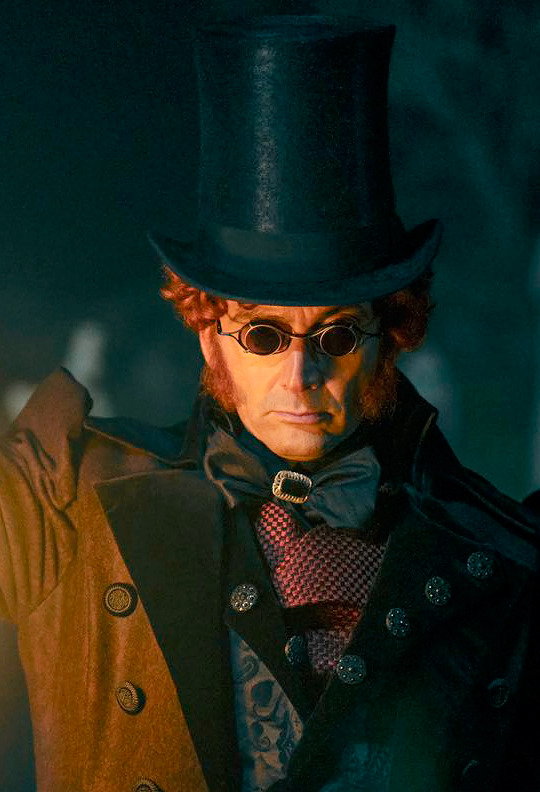
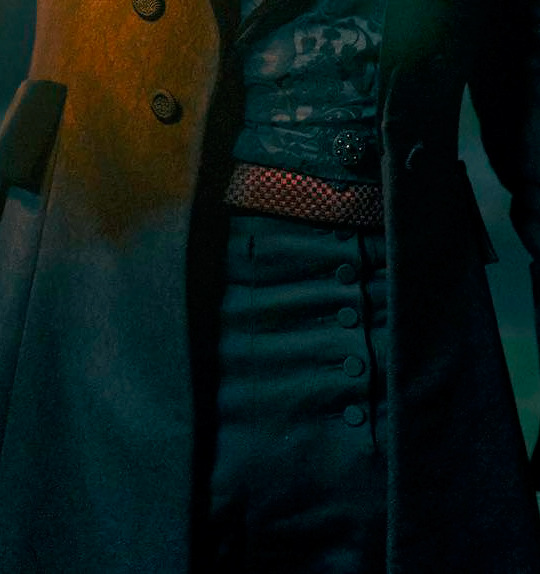
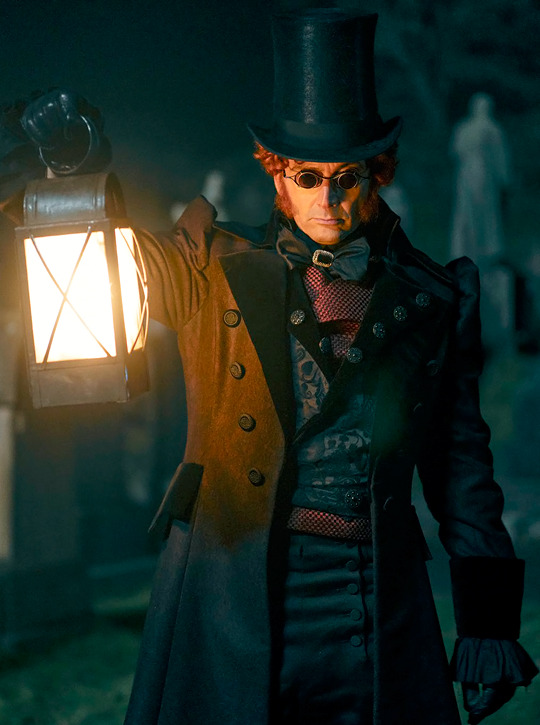

Crowley and Aziraphale in a graveyard in 1827 Edinburgh - Good Omens Season 2, episode 3
for Tennant Tuesday (or whatever day this post finds you)
#good omens#crowley#he's dressed like the dandiest dandy ever to dand#it's amazing#what a costume#good omens season 2#good omens costumes#good omens wardrobe#good omens 1827#19th c menswear#costume design#costume is character#costume details
2K notes
·
View notes
Text
*foaming at the mouth* hey do you know who Mary Anne Walkley was. Please let me tell you about Mary Anne Walkley.
#the ghost in the looking glass#the song of the shirt#Mary Anne Walkley#dress history#labor history#or rather#labour history#because she was British#textile history#Christina Walkley#who is the author of the book I’m currently reading about the exploitation of seamstrssses in 19th c England#but I have to imagine she’s related because British families are just like that#probably a distant relative considering the 130 year space in between them#but still
0 notes
Text
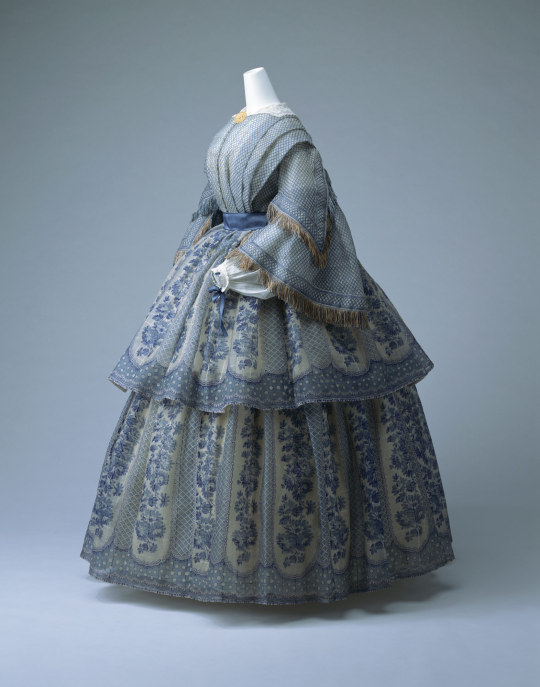
Day Dress
c.1855
England
This type of widely protruding skirt that appeared around the middle of the 19th century came to be known later under the name of the "crinoline style." As can be seen with this dress, large design motifs proved immensely effective on these voluminous skirts. The border pattern here is wood-block printed and repeats every 20.6 cm. Compared to small-scale designs, large patterns require a solid technique to avoid misalignment of the print colors. Considering that this mixed fabric of silk and wool is a material hard to print on, this dress with its bright and cheerful colors is a particularly fine example on how much cloth printing techniques had evolved.
The Kyoto Costume Institute
#day dress#fashion history#historical fashion#1850s#crinoline era#19th century#england#victorian#1855#blue#white#floral#flower print#kci
3K notes
·
View notes
Text
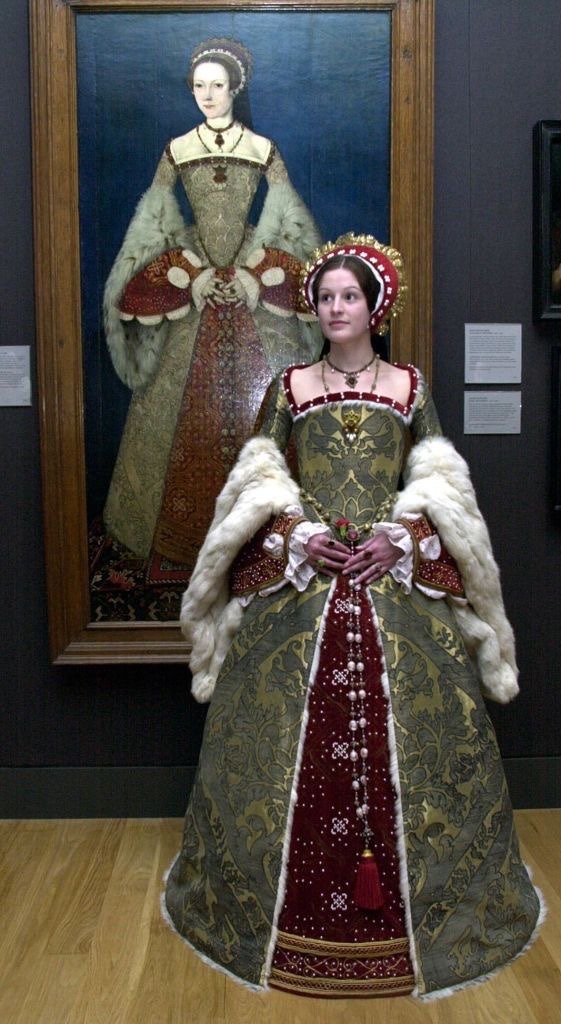
Annika Caswell a student from the Wimbledon School of Art wardrobe department, dressed as Catherine Parr, next to her portrait attributed to Master John, c. 1545 in the National Portrait Gallery, London. * The students are recreating portraits dating from the Tudor period to the 19th century which have been inspiration for their lavish costumes . (Photo by Rebecca Naden - PA Images/PA Images via Getty Images)
#art#artwork#fashion#historical#historical fashion#historical clothing#historical dress#history#long dress#museum#art school#the tudors#tudor history#tudor era#elizabeth tudor#fashion dress#dresses#dress#Catherine Parr#henry viii#1400s#1500s#england#high fashion#historical costuming#painting#dress up#red#green#beautiful
6K notes
·
View notes
Text
@ll-underestimated-ll
I hope you guys are ready for


2K notes
·
View notes
Text







Dress
c. 1890
“This silk dress has a standing lace collar as well as a lace yoke. There is floral applique on the center front and on the back of the boned bodice as well as on the sleeve cuffs. There is also ruching at the center front of the bodice and on the sleeves. The full sleeves are gathered at the shoulders and have velvet trim and lace trim at the cuffs. There are gathers at the waist and cartridge pleats and ruffles at the skirt hem. Features that indicate this dress is from the late 19th century are the hourglass silhouette, the monobosom, and the boned bodice.”
Grand Rapids Public Museum
#1890#1890s#fashion history#historical fashion#history of fashion#19th century#late 19th century#1800s fashion#19th century fashion#dress history#frostedmagnolias#purple
581 notes
·
View notes
Photo

Ruth, Lady Francis Granville Godolphin Osborne and Flora, Mrs William Bourchier Sherard Wrey wearing court dress, 1899
#1899#1890s#19th century#19th c. costume#court dress#courtier#courtiers#britain#19th c. britain#mdpcostume#photography#costume
150 notes
·
View notes
Text


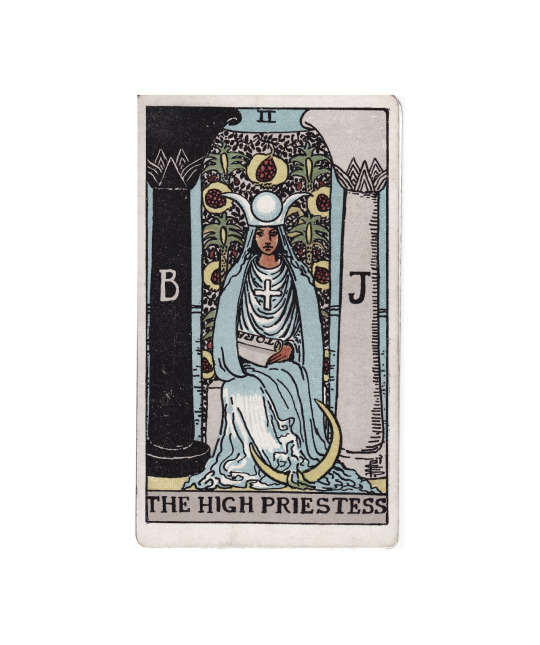
major arcana looks: THE HIGH PRIESTESS | khaite "romee" open-backed draped merino wool gown, marina eerrie "sacred" natural silk dress w/ hood, knobbly studio pearl double threader, knobbly studio silver mismatched fluted perfume funnel & holder earrings, di petsa silver metal belt, yvmin gemstone mesh fingertip rings, silver ewer (c. 19th cent.), kindred black "porphyria's lover" natural perfume, middaia "cathedrale pearl chains" necklace, schiaparelli surreal jewelry-pierced half-mask, alighieri "the ancient incantations" sterling silver bangle bracelet, alighieri "the ancient incantations" sterling silver ring, victorian silver hand mirror, laura benson "god seeds" pomegranate archival matte print
#major arcana#the high priestess#tarot#mine#request#look#outfit#marina eerie#khaite#knobbly studio#jewellry#silver#di petsa#laura benson#alighieri jewelry#middaia#yvmin#perfume#queue
233 notes
·
View notes
Note
Hi, this is a bit of a shot in the dark on my end, but I have a fashion inquiry (and I apologize if I sound ridiculous at all; I’m a bit at my wit’s end).
Is there a good way to research forms of casual Victorian garb? I feel like I’m going a bad route by inserting the word ‘Victorian’ into any search because it results in rather fancy things (or modern twists on such that are purchasable). Would it be wiser to site dates in search? Is this going to fruitless?
Sorry for taking up any time if this is out of wheelhouse. But if you do answer, I really appreciate it.
I'll do my best! Focusing on womenswear, because...well, that's what I know best. But if anyone wants to chime in about the gentlemen, please do so!
So, casual Victorian doesn't always read as Casual to us nowadays. Standards of casual clothing- that is, clothing one wears for everyday life when nothing special is going on -were rather higher than we have today.

This is an illustration of matchstick-makers in London's East End c. 1871, done by one Herbert Johnson. The women have their sleeves rolled up and aprons on, but when they leave the factory (rolling their sleeves down, adding hats to go outside- which most of them would have done; it was part of looking Respectable) they might be indistinguishable to us from any other women of the same era wearing not particularly bustle-y skirts. Some of them probably have on the commonplace Matching Skirt And Bodice dress format of the era; others have on blouses made from the same patterns as those worn by middle- and upper-class women.
Also note that they have on ribbons, chokers, earrings...they're just like us. They like wearing things that make them feel Put Together, even though they're doing one of the lowest-valued, most dangerous jobs open to women at the time. Because people have always been people, regardless of time or social class.
And for middle-class women and up, Casual might be even harder to distinguish from "fancy" to us today.

This is a mid-late 1880s day dress with a skirt length suitable for lots of walking, from Augusta Auctions. Could not tell you the social status of the woman who owned it, genuinely. Probably not the absolute poorest of the poor, but beyond that...this is a dress you could potentially wear to run errands. Even to go to work, if your job wasn't especially physical. Because. I don't know. It's a Day Dress. You wear it for day things. It's not especially formal, because then it would be made of a more delicate material and probably have a longer skirt (unless it was a Serious Dancing ball gown). Possibly also a lower neckline and puffed sleeves, if it was exclusively for the most formal events.
The idea that a dress was "fancy" just because it had ornamentation wasn't really in their cultural vocabulary.

Here is a group of women playing croquet in what looks like the early-mid 1870s. They're just hanging out! Having a good time! They're probably middle or upper class, but that's what they wear to chill outside with friends- to play a lowkey sport, even.
So yeah, it can be hard to map Victorian everyday clothing onto our "jeans and t-shirt" understanding of what makes an outfit casual. They had skirts and blouses for most relevant decades, but even those outfits often end up looking formal to us nowadays because of what I call Ballgownification- the idea that, since we only wear clothes that look even vaguely like what they had for extremely dressy occasions, we assume everything we see of their clothing was dressy.
(Someone please ask for my rant about Ballgownification)
Searching for "day dress," "walking dress," "blouse," "blouse waist," and "shirtwaist" (the last for the late 19th-early 20th century when that term became commonplace) might help. Best of luck!
#victorian#history#fashion history#dress history#clothing history#ask#madsk3tch#even just Throwing Something On looks dressy if all you have to throw on is. that.#I make a lot of my clothes from extant patterns and people comment on how dressed-up and put together I look#which is very kind but. these are magazine patterns. anyone had access to them#and I often even take off some of the recommended trims no less#a casual blouse waist from 1869 looks quite dressy to a modern audience#long post
199 notes
·
View notes
Text
Color Symbolism in Newsies
Newsies (1992) is much beloved for it's use of color. From the pastels of the ensemble newsies to Jack's distinctive red bandana, the use of certain colors in the film do an excellent job of helping to tell the story. Exhibit A: the contrast between Jack's bandana and David's blue shirt which creates a visual representation of the contrast between the personalities of our two main characters.
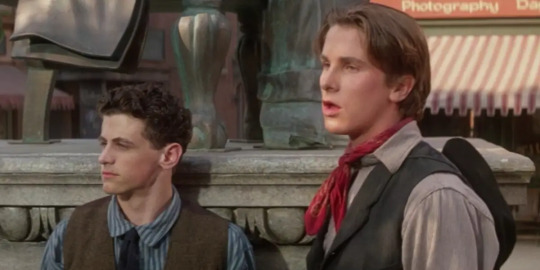
Coupled with historical context and meanings, there are many connections between and insights into characters that can be gained by paying close attention to how Newsies uses color.
For the sake of brevity, I'll just be analyzing the colors in Newsies as they are used in costuming and ignoring set design or we could be here all night.
Red
In political history, red has often stood for revolution and rebellion. It's no wonder then that the leaders of Brooklyn and Manhattan both wear red. Red also indicates passion and bravery, which are key to the strike.
Besides Jack and Spot, Pulitzer wears red when Jack is brought to his study and attempts to bribe Jack to scab. Aka, Pulitzer is dressed in red at the height of exercising his power over Jack.
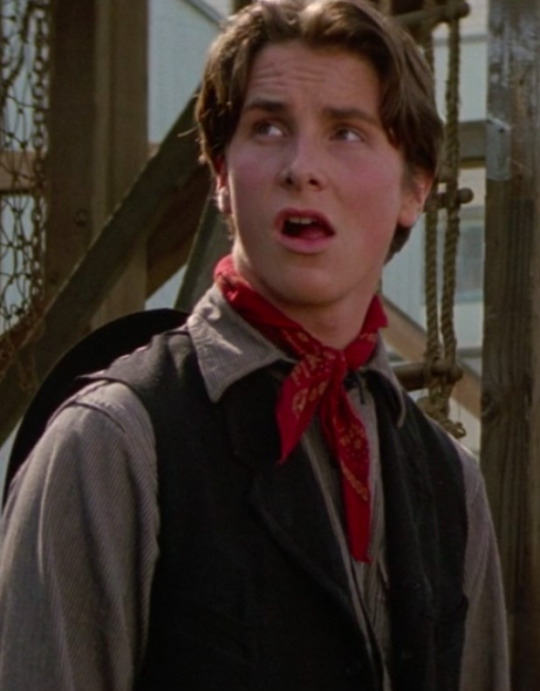

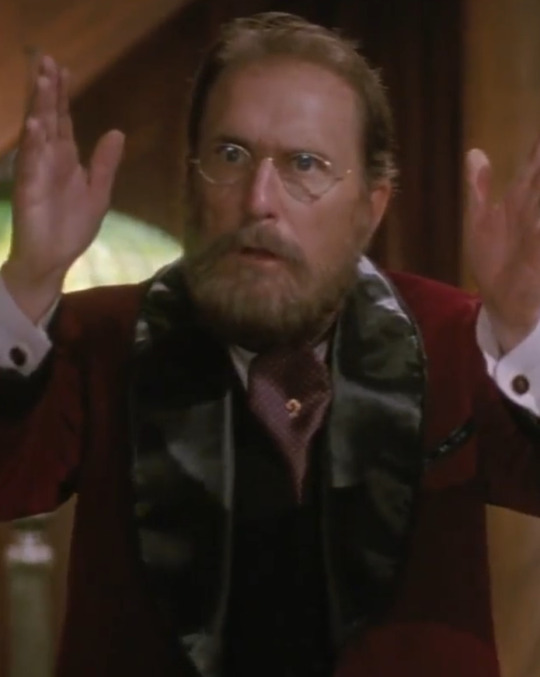
Center: Jack And The Beanstalk. Illustration for unidentified book of children's nursery literature, with Kronheim illustrations, c 1870
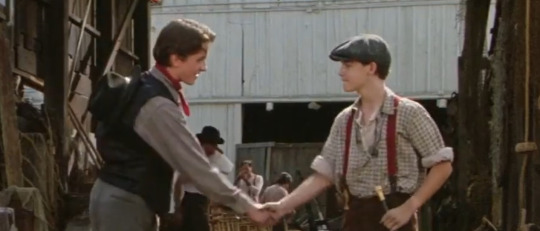
@sarahjacobs has an excellent post that talks about red symbolizing power in Newsies which you can read here.
Another interesting meaning for red comes from Jewish belief where the color red is linked to sin, but also to sacrifice and redemption. Jack scabbing to protect David and his friends after Pulitzer threatens them comes to mind.
You could consider Jack dawning his bandana again during "Once And For All" as symbolic of his redemption and reconciliation with the Jacobs and the newsies.
Red: Uncovering the Historical Significance of a Bold Color - Symbol Sage Political colour, Red - Wikipedia What colors symbolize Jewish culture?, Red
Pink
When most people think of pink, they often associate it with femininity. However, pink being a "girl" color is actually a modern idea which only gained significant popularity in the 1950s. Before this, pink was worn beginning in the 1700s by European aristocrats and became a color of success and class.
This meaning makes pink fitting for Miss Medda Larkson, the Swedish Meadowlark.
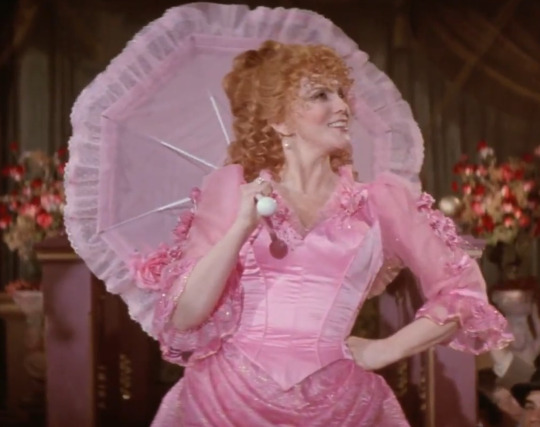
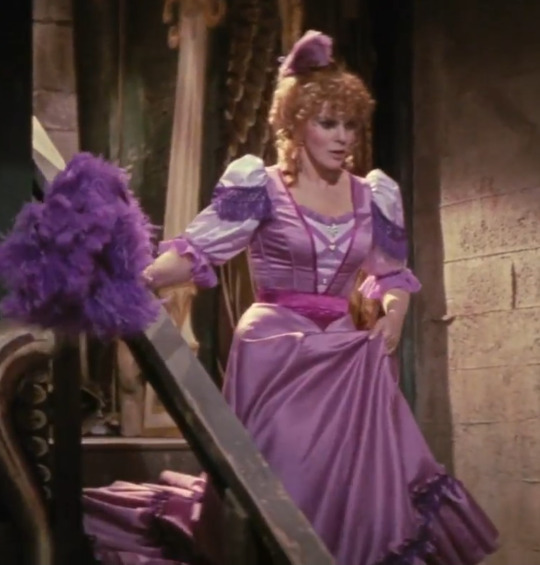
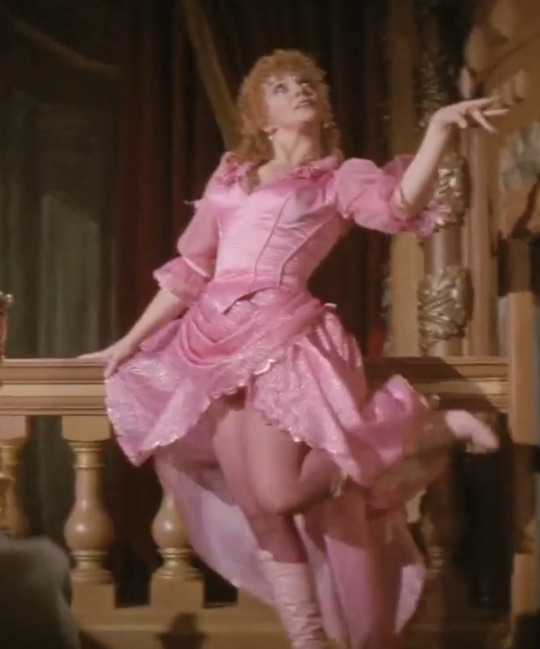
In the later half of the 19th century in particular, pink was also tied to youth, which is why we see Sarah and several newsboys alike in the color. As The Art of Dressing Well (1870) dictated, pink "is only fitted for the young. It is a charming color, and those to whom it is suited look very graceful in it."
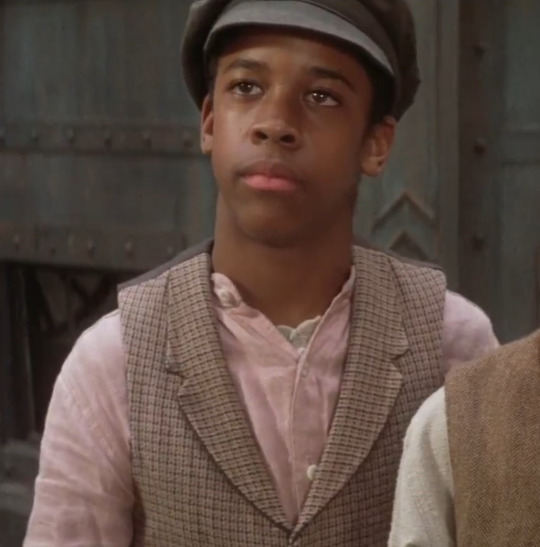
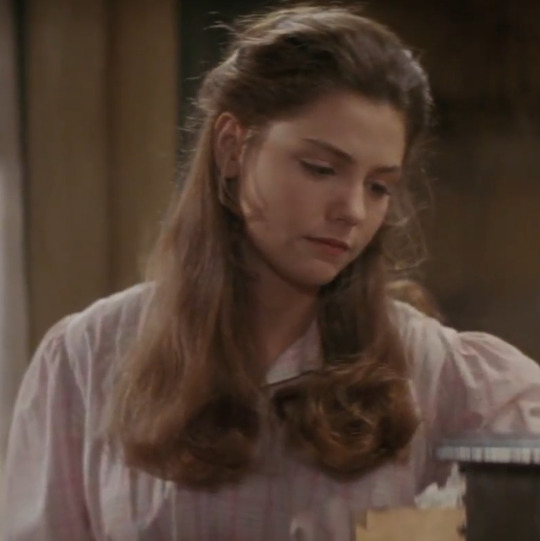
Because it was also seen as a "paler shade of red", pink had masculine connotations that were also associated with red. Pink therefore occasionally shares the meanings of passion, aggression, and bravery with its parent color.
The first time Sarah wears pink is when she discovers Denton's article and becomes directly involved with and passionate about the strike.
Oscar Delancey, arguably the more aggressive Delancey, wears a pink undershirt. You also have Kid Blink in a pink shirt who is known for being very passionate and short tempered.
The shade of pink that Blink wears is the same shade as Sarah's shawl which she wears when she punches Morris Delancey in the face. Medda too isn't afraid to fight back and speak her mind at the rally. She and Sarah both exhibit bravery.
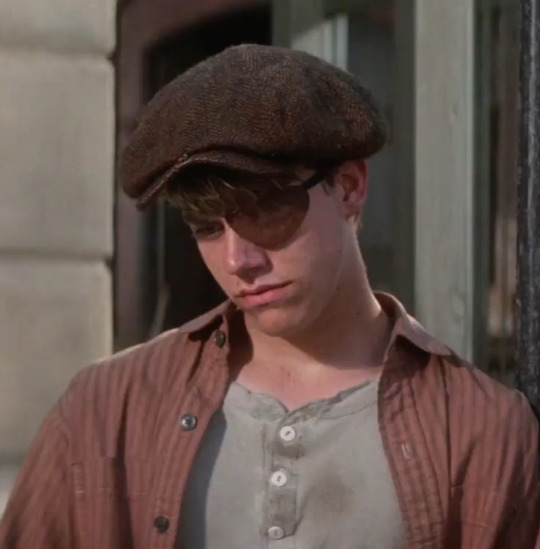
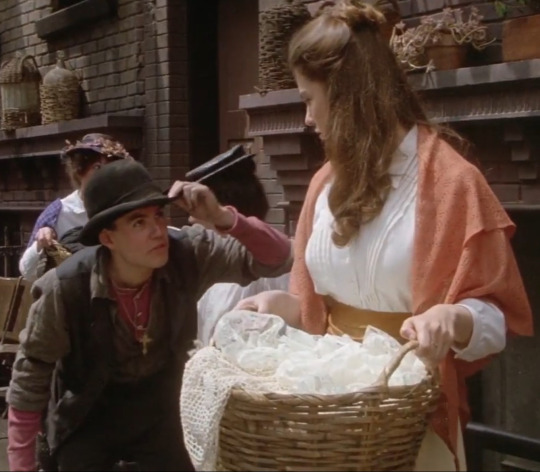

Refined, rebellious and not just for girls: A cultural history of pink | CNN Tickled pink: colors in the Victorian era - Recollections Blog The complicated gender history of pink | CNN
Blue
You've likely heard the phrase "true blue" before, this is because blue has a reputation stretching far back in history for representing loyalty and trust. Blue also often represents intelligence and tranquility. It's extremely fitting then that David Jacobs is always seen in blue, especially because he values honesty and prefers peaceful means of protest to violence whenever possible.
The color blue, specifically tekhelet or a shade of blue described in the Torah, holds significant weight in Judaism. It is sometimes referred to as the 'color of God’s Glory’ in Rabbinic literature and has been used in ancient and modern Jewish symbolism alike. This connects the color blue to the Jacobs family as a whole.
Even without the association to Judaism, the Jacobs family puts high value in education and truth. After all, it was Mr. Jacobs who taught his children not to lie and who insists on David and Les returning to school.
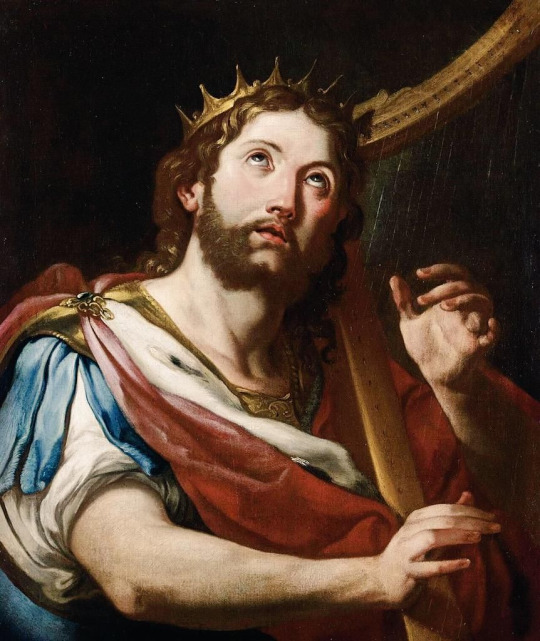

Left: King David with the Lyre, 18th century Sebastiano Conca (1680-1764)
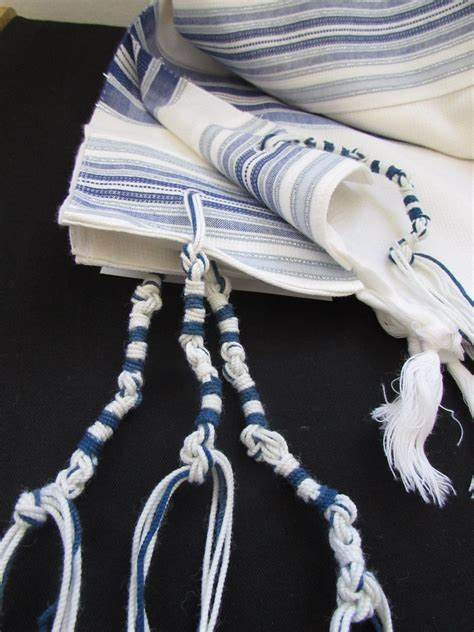
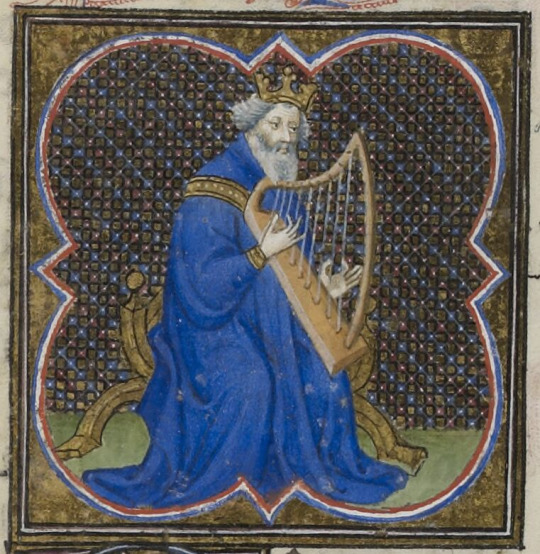
Left: Tekhelet (תְּכֵלֶת) or "sky blue" tzitzit; Right: King David. Psalterium et horae ad usum Sanctae Capellae Parisiensis, 1360-1400
Because blue was historically both an expensive dye and pigment for painters, blue was worn by and used in art for only the most important subjects. Thus, blue became symbolic of nobility.
To the Renaissance artists, there was no subject more important than the Virgin Mary. While blue had been tied to female figures and goddesses previously across several cultures, Renaissance depictions of Mary led to blue becoming widely associated with humility, grace, and femininity in the Western world.


Left: Periwinkle flower, a symbol of grace and femininity and a Christian symbol of the Virgin Mary
Pastel shades of blue in particular became commonly feminine colors suitable for women and girls in the 18th and 19th centuries. Hence, it makes sense that Sarah would wear blue at the rally.
All You Need to Know About What the Color Blue Symbolizes | Slightly Blue What does blue mean in Judaism? | Slightly Blue The Secret History of the Color Blue — Google Arts & Culture The History of Blue as a Women’s Color
Purple
Because of its rarity in the natural world, and the labor historically needed to create purple dye, purple was highly prized and was considered a symbol of high status and honor.
Spot Conlon is the only member of the our main cast of newsies to wear the color purple, which visually symbolizes the newsboys' respect for him, his reputation, and his involvement in the strike.
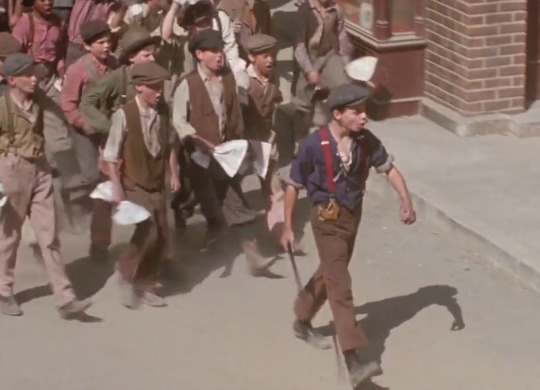
The purple detailing on Medda's costume when we first meet and are introduced to her by Jack is also an indication of the respect other characters have for her.
Purple can also denote ambition and independence, characteristics that suit both Spot and Medda well seeing as Spot has "moved up in the world" and Medda owns her own theater.
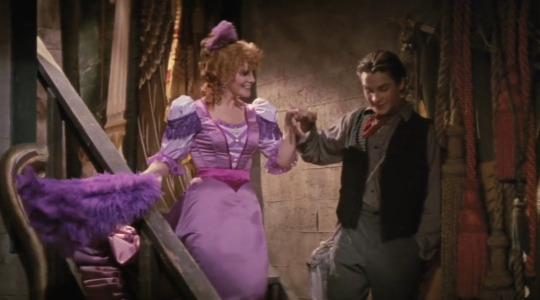
Why is Purple Considered the Color of Royalty? | HISTORY Purple: Color Meaning, Associations, and Effects
Black and Grey
What about lack of color? In Newsies, we can easily tell our heroes from the villains through the use of color. Or can we?
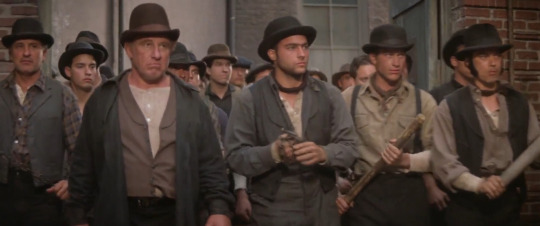
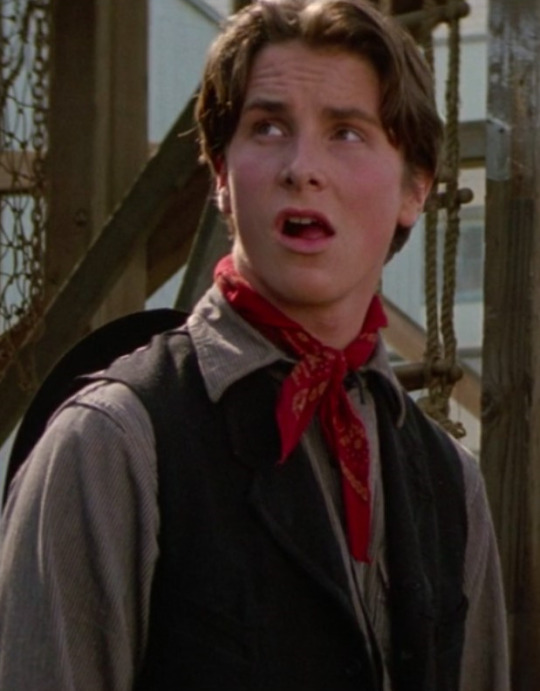
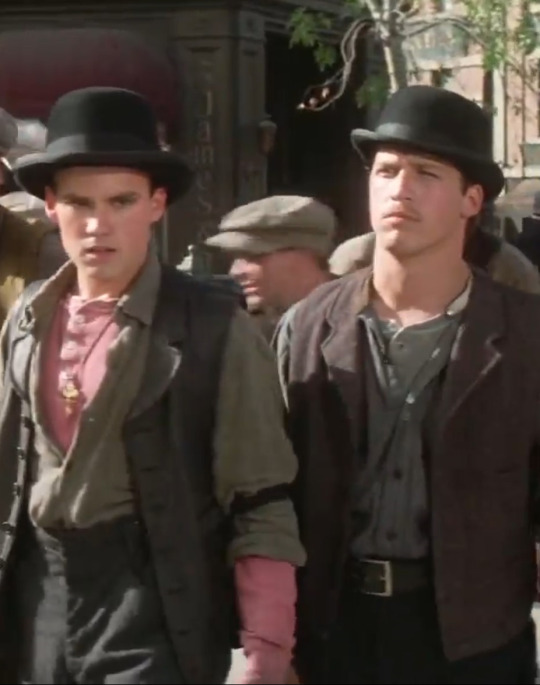
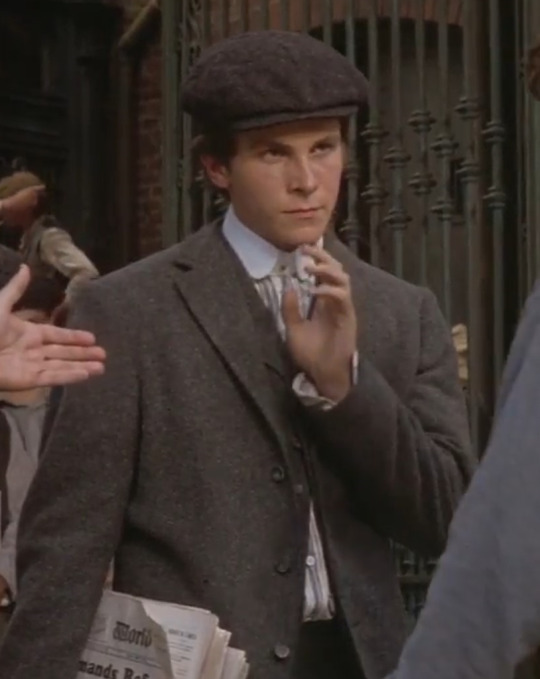
The villains or "opposing forces" are all dressed in dark greys or black as opposed to the pastels and shades of brown that the newsies and their allies wear. Jack Kelly is an interesting exception, dressed head to toe in dark hues with the one color being the red of his bandana. Visually, Jack could fit into a crowd of newsboys, or of scabs and goons.
Black has long been associated, for obvious reasons, with darkness and secrecy. Similarly, grey is often seen as representing foreboding, moral ambiguity, and evasiveness.
The use of grey and black for Jack clues us into the fact that he is lying about his past and his family and also foreshadows his betrayal of the strike.
Which Colour represents evil?
#I like overthinking things :)#wow this took way longer than I expected it to#I love this movie a normal amount#newsies#newsies 1992#1992 newsies#1992sies#92sies#color symbolism#how many pictures can I add to one post and it still be coherent challenge#analysis#jack kelly#david jacobs#spot conlon#sarah jacobs#medda larkson#my writing#nerd alert!
55 notes
·
View notes
Text


Empire style ensemble
1805-10, Napoleonic era
probably French
Source: The Met
#ensemble#empire style#empire#napoleonic era#19th century#first french empire#dress#fashion#spencer#art#french empire#napoleonic#french#1800s#1805#empire era#France#history of fashion#fashion history#pretty#early 1800s#early 19th century#french art#silk#1989.190a–c#regency era#regency#style
24 notes
·
View notes